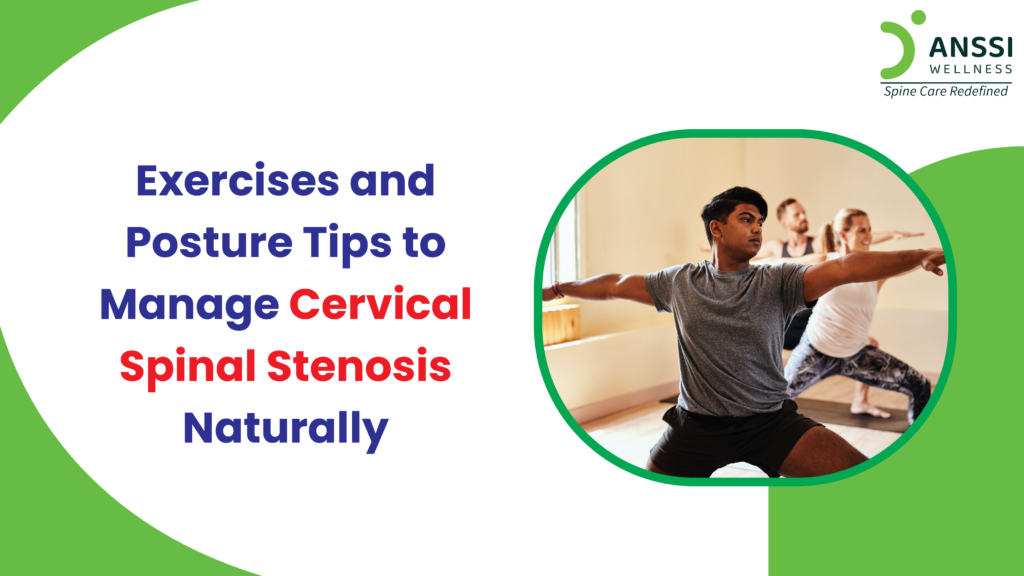Cervical spinal stenosis is a condition that is more common in adults over the age of 50 and it tends to affect men slightly more than women. Here, the neck’s spinal canal narrows, placing pressure on the spinal cord and nerves. While it can be challenging, natural management methods like posture correction and gentle exercises can greatly help you to reduce discomfort, improve mobility, and maintain quality of life, without the need for medicines, injections, or surgery.
Understanding Cervical Spinal Stenosis
Age-related changes in the spine are usually the cause of cervical spinal stenosis. It occurs when spaces within the cervical spine become narrow, compressing the spinal cord and surrounding nerves.
This condition can cause symptoms such as:
- Neck pain or stiffness
- Weakness, tingling, or numbness in the hands or arms
- Difficulty with balance or coordination
- Headaches originating from the neck
As our population ages and lifestyles become more sedentary, the prevalence of cervical stenosis is steadily increasing. However, you can manage its symptoms and continue daily activities comfortably by making a few important changes to your daily routines.
Posture Tips for Relief and Prevention
Good posture is one of the most powerful tools in managing cervical spinal stenosis naturally. The way you sit, stand, and sleep affects the alignment of your spine and can either relieve or worsen pressure on your spinal cord.
Here are some helpful tips:
1. Maintain a Neck-Neutral Posture
Always aim to keep your neck aligned with your spine. Whether you’re standing, sitting, or walking, avoid tilting your head too far forward or backwards.
2. Avoid Slouching While Sitting
Poor sitting posture places extra pressure on your cervical spine. Use a chair with good lumbar support and sit up straight with your shoulders relaxed. Keep your screen at eye level to avoid leaning forward.
3. Ergonomic Adjustments at Workstations
Your desk, chair, and computer setup should support a neutral neck position. Adjust your monitor so that it’s at eye level, use a chair that supports your lower back, and keep your keyboard and mouse within easy reach to avoid strain.
4. Use Proper Pillow Support While Sleeping
A pillow that’s too high or too flat can put your neck in an awkward position. Select a cushion that supports your neck’s natural shape. It’s best to sleep on your side or back with the right support.
Simple Exercises to Ease Stiffness and Improve Strength
Regular movement is essential to keep the neck flexible, maintain muscle strength, and improve circulation. These exercises are simple, require no equipment, and can be done at home.
However, always perform them slowly and gently, and stop if you feel pain.
1. Neck Stretches
This lessens stiffness and stretches the neck muscles.
- Bring your ear close to your shoulder by gradually tilting your head to one side.
- Hold for 5–10 seconds.
- Repeat on the other side.
2. Shoulder Blade Squeezes
Here, the muscles in the upper back that support the neck are strengthened.
- With your arms at your sides, take a seat or stand.
- Gently pull your shoulder blades together as if you are trying to pinch them.
- Hold for 5 seconds, then do it 10 more times.
3. Chin Tucks
This exercise helps to improve posture and develop the deep neck muscles.
- While sitting or standing, pull your chin back slowly, making a double chin without tilting your head.
- Hold for 5 seconds, then do it 10 more times.
4. Gentle Yoga for Flexibility
Yoga poses like the cat-cow stretch, child’s pose, and seated twists can gently mobilise the spine, increase flexibility, and reduce tension. Always avoid any pose that strains the neck or causes discomfort.
Regularly performing these exercises can help improve your neck’s range of motion, support the spine’s alignment, and reduce nerve irritation.
Lifestyle Tips for Extra Support
In addition to posture and exercise, the following habits can also support your journey to a healthier spine:
- Stay active: Gentle daily movement like walking improves circulation and spinal health.
- Stay hydrated: Water helps maintain the elasticity and shock-absorbing properties of spinal discs.
- Anti-inflammatory diet: Include foods like leafy greens, turmeric, ginger, and omega-3-rich nuts and seeds to reduce inflammation naturally.
- Manage stress: Stress causes muscle tension in the neck and shoulders. Deep breathing and meditation can help.
- Avoid heavy lifting: If needed, use proper techniques and avoid putting extra strain on your neck.
Stay mindful, move with intention, and listen to your body—your spine will thank you.
About ANSSI:
ANSSI Wellness focuses on improving the quality of life for patients suffering from spinal issues, aiming to provide relief where other conventional treatments have failed. Through advanced non-surgical spinal decompression treatment, ANSSI is committed to helping patients avoid surgery and recover in a safe, effective, and compassionate environment.
Connect with ANSSI Wellness on LinkedIn, Instagram, and Facebook for expert guidance.



